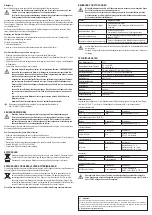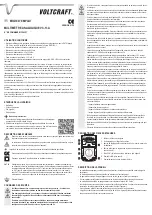
c) Resistance measurement
Make sure that all the circuit parts, switches and components and other objects to be
measured are disconnected from the voltage and discharged at all times.
Proceed as follows to measure resistances:
• Select the measuring function “Ω” with the rotary switch .
• Connect the black measuring line to the COM socket (5) and the red measuring line to the socket “Ω” (6).
• Touch the two measuring tips to each other and wait until the pointer has stabilised. A value of approx.
0 Ohm must be displayed. In case of a deviation, adjust the pointer with the 0 Ohm calibration control (3)
to 0 Ohm. Always check this when changing the measuring range.
• Read off the measuring value on the scale “Ω”.
• In the “x1k” measurement range, multiply the displayed value by a factor of 1000 to get the measured
value e. g. 5 Ω (display) x 1000 = 5 x 1000 = 5 kΩ (measured value).
• In the “x10” measurement range, multiply the displayed value by a factor of 10 to get the measured value
e. g. 50 Ω (display) x 10 = 50 x 10 = 500 Ω (measured value).
• After completing the measurement, remove the measuring tips from the measuring circuit and switch the
multimeter off (rotary switch position: “OFF”).
d) Direct current measurement
Never exceed the max. permitted input values in the respective measuring ranges.
Current measuring operations are permissible only in circuits up to max. 300 V.
Proceed as follows to measure direct currents up to 250 mA/DC voltages:
• Select the measuring function “mA” with the rotary switch .
• Connect the black measuring line to the COM socket (5) and the red measuring line to the socket “mA” (6).
• Disconnect the object to be measured from the mains.
• Pay attention to the correct polarity (red = + / black = -) and connect the two measuring tips in series with
the measuring object (battery, circuit, etc.).
• In the case of a pole reversal, the needle deflects in the negative direction. This could damage the meter
mechanism. Stop the measurement at once and repeat the measurement with the correct polarity.
• Read off the measuring value on the scale “mA”.
• Disconnect the measured object from the mains and remove the measuring tips from the measuring
circuit after the measurement is completed. Switch off the multimeter (rotary switch position “OFF”).
e) Attenuation measurement in dBm
The multimeter enables absolute “dB” measuring in circuits with an impedance of 600 Ohm. Measurements
are made in the “10 V~” range. 0 dB = 1 mW (0.775 V).
Proceed as follows for the measurement:
• With the rotary switch, select the measuring range “10 V~“.
• Connect the black measuring line to the COM socket (5) and the red measuring line to the socket “V” (6).
• Now connect the two measuring probes in parallel to the object to be measured (generator, switch, etc.).
• Read off the measured value on the scale “dB”. Read the voltage on the scale “AC10V”.
• If signals with a direct voltage ratio are to be measured, a capacitor of >0.1nF must be connected in
series to the measuring lines (decoupling).
• After completing the measurement, remove the measuring tips from the measuring circuit and switch the
multimeter off (rotary switch position: “OFF”).
f) Battery test
The multimeter tests 1.5 V or 9 V batteries with a low load. This prevents faulty measurements during
open-circuit operation and gives significant clues to the battery condition.
"REPLACE" indicates that the battery must be replaced.
"?"
indicates that the battery can still be used only for low power consumer loads.
"GOOD"
indicates that the battery is OK.
To test the batteries, proceed as follows:
• With the rotary switch select the measuring function “BAT” and the measuring range 1.5 V or 9 V.
• Connect the black measuring line to the COM socket (5) and the red measuring line to the socket “V” (6).
• Pay attention to the correct polarity (red = + / black = -) and connect the two measuring tips to the
battery.
• In the case of a pole reversal, the needle deflects in the negative direction. This could damage the meter
mechanism. Stop the measurement at once and repeat the measurement with the correct polarity.
• Read off the measured value on the scale “BAT”.
• After completing the measurement, remove the measuring tips from the measuring circuit and switch the
multimeter off (rotary switch position: “OFF”).
CLEANING AND MAINTENANCE
General information
To ensure the accuracy of the multimeter over an extended period of time, it should be calibrated once a
year.
Information on changing the battery and fuse appears below.
Regularly check the technical safety of the device and the measuring cables, e.g. for
damage to the housing or crimping, etc.
Never operate the meter when it is open. ! RISK OF FATAL INJURY!
EXPLANATION OF SYMBOLS AND SIGNS
Overload, the resistance measuring range was exceeded
Symbol for the built-in battery data
Symbol for the built-in fuse
OFF
Switch position OFF
COM
Measurement reference potential, - for DC
VmAΩ
Measurement input for measurement potential, + for DC
AC
Symbol for alternating current
DC
Symbol for direct current
V
Volt (unit of electric voltage)
mA
Milliampere (unit of electric current, exp.-3)
Ω
Ohm (unit of electrical resistance)
x10
The resistance value read must be multiplied by 10
x1k
The resistance value read must be multiplied by 1000
dB
Decibels, attenuation in the 10 V AC voltage measurement circuit
(0 dB = 1 mW/600 Ohm = 0.775 V)
BAT
Battery test
9 V/1.5 V
Measurement range for batteries with 9 V or 1.5 V nominal voltage
REPLACE The tested battery must be replaced
?
The tested battery should be replaced as soon as possible
GOOD
The tested battery can be used
START-UP
Before you can work with the measuring device in the resistance measurement range, you must
first insert the enclosed battery. Insert the battery as described in the chapter “Cleaning and Mainte-
nance”.
Rotary switch (4)
• The individual measuring functions and ranges can be set using the rotary switch.
• If the rotary switch is set to “OFF”, the measuring device is switched off.
• Always turn the meter off when it is not in use.
• An automatic cut-off does not occur in the resistance range.
WEIGHING
Do not exceed the maximum permitted input values under any circumstances. Never
touch circuits or parts of circuits when they may contain voltages greater than
33 V/ACrms or 70 V/DC! Risk of fatal injury! Before every measurement, check the
meter and the connected measuring leads for damage such as cuts, cracks or pinches.
Remove defective measuring leads immediately and replace them with new measuring
cables. Defective measuring leads must no longer be used. ! Risk of fatal injury!
Before changing the measuring range, the test probes have to be removed from the
measured object.
Always start each measurement with the largest measuring range. Then gradually
change to a smaller one to achieve an exact measured result. The best precision occurs
in the mid-scale range (scale range ca. 70° to 110°).
The measuring results at the rotary switch correspond to the scale end value. For reading, always select
the corresponding value (e.g. scale 10 for the measuring range 10).
a) Zero adjustment
Before each measurement, adjust the zero position with the calibration screw (2) (scale value 0 V). There
must be no measuring signal on the measuring lines.
b) Measuring AC and DC voltages
Do not exceed the maximum permitted input values under any circumstances.
Proceed as follows to measure direct current (DC) voltages:
• Select the measuring function V with the rotary switch
.
• Connect the black measuring line to the COM socket (5) and the red measuring line to the V socket (6).
• Pay attention to the correct polarity (red = + / black = -) and connect the two measuring tips in parallel to
the object to be measured (battery, circuit, etc.).
• In the case of a pole reversal, the needle deflects in the negative direction. This could damage the meter
mechanism. Stop the measurement at once and repeat the measurement with the correct polarity.
• Read off the measured value on the scale “V”.
DC V range
V scale for reading
Multiplier
2.5
0 - 250
0.01
10
0 - 10
1
50
0 - 50
1
250
0 - 250
1
300
0 - 300
1
• After completing the measurement, remove the measuring tips from the measuring circuit and switch the
multimeter off (rotary switch position: “OFF”).
Proceed as follows to measure AC voltages:
• Select the measuring function V with the rotary switch
.
• Connect the black measuring line to the COM socket (5) and the red measuring line to the V socket (6).
• Now connect the two measuring probes in parallel to the object to be measured (generator, switch etc.).
• Read off the measured value on the scale “V”.
• After completing the measurement, remove the measuring tips from the measuring circuit and switch the
multimeter off (rotary switch position: “OFF”).












